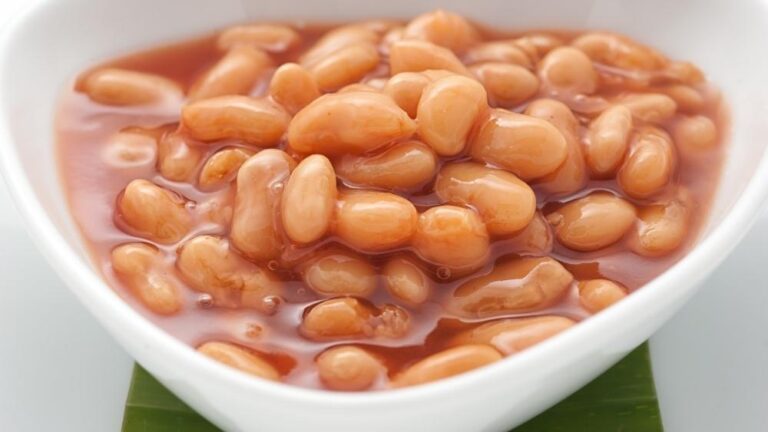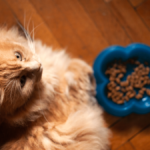Cats are carnivores by nature, and their dietary needs are primarily met through high-quality animal-based proteins. However, cat owners often wonder if we can add plant-based foods to their diet, such as beans. Beans are a rich source of fiber, vitamins, and minerals and can offer some health benefits to cats when fed in moderation.
However, it’s important to understand the potential risks and side effects of feeding cats beans and the proper way to prepare and serve them. In this article, we will explore the question, “Can cats eat beans?” and discuss the nutritional benefits, potential risks, and how to prepare and serve beans for your feline friend properly.
Understanding a Cat’s Nutritional Needs
Cats are obligate carnivores, requiring a diet high in animal-based protein to thrive. Their natural prey consists of small rodents and birds rich in protein, fat, and other essential nutrients.
- Carnivorous Diet: Cats are obligate carnivores, requiring a diet rich in animal protein to survive and thrive. Their digestive systems are designed to process and utilize the nutrients found in meat efficiently.
- Essential Nutrients: In addition to protein, cats require specific vitamins and minerals to maintain their health, including vitamin A, taurine, and arginine. These nutrients are typically found in animal-based foods and can be challenging to obtain from plant sources.
- Protein Requirements: Cats need more protein in their diet than other animals, with adult cats needing around 2-4 grams of protein per kilogram of body weight per day. Without sufficient protein, cats can develop muscle wasting and other health problems.
- Water Intake: Cats have a low thirst drive and are prone to dehydration, leading to urinary tract and other health problems. Their diet should include a high moisture content to help keep them hydrated, typically in wet food.
- Balanced Diet: A balanced diet for a cat includes a combination of protein, fat, carbohydrates, vitamins, and minerals. While some plant-based foods can provide these nutrients, ensuring a complete and balanced diet without animal-based foods can be challenging.
Types of Beans That Are Safe for Cats
Not all types of beans are safe for cats to eat. Some beans, such as uncooked or undercooked kidney beans, contain lectins, which can cause vomiting, diarrhea, and other digestive problems in cats. Additionally, some beans may be too high in certain nutrients, such as sodium or phosphorus, which can harm cats in large amounts.
However, some beans are safe and even beneficial for cats to eat in moderation. These include:
- Green Beans: Green beans are a low-calorie, high-fiber vegetable that can help support a cat’s digestive health. They are also a good source of vitamins and minerals, such as vitamin C and potassium.
- Lima Beans: Lima beans are a good source of plant-based protein and fiber, which can help support a cat’s overall health. However, they should be cooked and served plain, without any added salt or seasonings.
- Soybeans: Soybeans are a good source of protein and amino acids for maintaining a cat’s muscle mass and overall health. However, it’s important to avoid giving cats soy products that contain added sugars, salt, or other ingredients that may harm their health.
- Black Beans: Black beans are a good source of plant-based protein and fiber, as well as vitamins and minerals such as iron and folate. They should be cooked and served plain, without any added salt or seasonings.
When incorporating beans into a cat’s diet, it’s important to do so in moderation and to consult with a veterinarian to ensure that the beans are safe and appropriate for their specific nutritional needs.
Can Cats Eat Beans?

Although cats require a protein-rich diet as obligate carnivores, they can still consume certain beans in moderate amounts. However, it’s important to remember that not all types of beans are safe or appropriate for cats to eat.
Some types of beans, such as green beans and lima beans, can be a healthy addition to a cat’s diet in small amounts. These beans are low in calories and fiber, which can help promote healthy digestion and weight management.
However, other beans, such as raw or undercooked kidney beans, can be toxic to cats. Kidney beans contain lectin, which can cause vomiting, diarrhea, and other digestive issues if ingested in large quantities.
Additionally, beans should never be used as a replacement for animal-based protein in a cat’s diet. Cats require animal-based protein to meet their nutritional needs, and feeding them a diet that is too high in plant-based protein can lead to nutritional deficiencies and other health issues.
In summary, while some types of beans can be fed to cats in moderation, it’s important to consult a veterinarian before adding new foods to a cat’s diet to ensure they are safe and appropriate for their specific nutritional needs.
The Benefits of Feeding Your Cat Beans
While cats are obligate carnivores and require a diet high in animal-based protein, some types of beans can provide certain benefits when fed to cats in moderation. Here are some potential benefits of feeding your cat beans:
- Fiber: Some types of beans, such as green and lima beans, are high in fiber. Fiber is important for maintaining a healthy digestive system, promoting regular bowel movements, and preventing constipation.
- Protein: Some types of beans, such as black beans and soybeans, are high in protein. While cats require animal-based protein to meet their dietary needs, incorporating some plant-based protein into their diet can help support overall health.
- Vitamins and minerals: Some types of beans, such as kidney beans and pinto beans, are good sources of vitamins and minerals, such as iron, folate, and potassium. Incorporating various nutrient-dense foods into a cat’s diet can help them get all the essential vitamins and minerals they need.
- Weight management: Feeding cats a diet high in fiber and protein can help promote feelings of fullness and prevent overeating. This can be especially beneficial for overweight or obese cats needing to lose or maintain a healthy weight.
It’s important to remember that not all types of beans are safe or appropriate for cats to eat. Some beans, such as raw or undercooked kidney beans, can be toxic to cats. Additionally, beans should never be used as a replacement for animal-based protein in a cat’s diet. Before adding new foods to a cat’s diet, it’s important to consult with a veterinarian to ensure they are safe and appropriate for their specific nutritional needs.
Potential Risks and Side Effects of Feeding Cats Beans
Feeding your cat beans can have potential risks and side effects if not done properly. Here are some more details:
- Toxicity: Some types of beans, such as raw or undercooked kidney beans, can be toxic to cats. Kidney beans contain lectin, which can cause digestive issues such as vomiting, diarrhea, and abdominal pain. If your cat ingests a significant amount of raw or undercooked kidney beans, it can lead to more severe symptoms like lethargy, dehydration, and even kidney failure.
- Digestive issues: Beans can be difficult for cats to digest, which can lead to bloating, gas, and other digestive issues. Feeding too many beans can also lead to diarrhea, constipation, and other gastrointestinal problems.
- Nutritional imbalances: While some beans can be a healthy addition to a cat’s diet in small amounts, beans should never replace animal-based protein. Cats require animal-based protein to meet their nutritional needs, and feeding them a diet that is too high in plant-based protein can lead to nutritional deficiencies and other health issues.
- Allergies: Some cats may have an allergic reaction to beans, which can cause symptoms such as itching, rashes, and gastrointestinal problems.
It’s important to consult a veterinarian before adding new foods to your cat’s diet to ensure they are safe and appropriate for your cat’s specific nutritional needs. When feeding beans to your cat, start with a small amount and monitor your cat for any signs of digestive issues or other adverse reactions. If your cat experiences negative symptoms, stop feeding them beans and consult your veterinarian.
Preparing and Serving Beans for Your Feline Friend
If you have decided to feed your cat beans, preparing and serving them properly is important to avoid potential risks and side effects. Here are some tips for preparing and serving beans for your feline friend:
- Cooked beans: Cooked beans are the safest option for cats. To prepare beans for your cat, cook them thoroughly until they are soft and easy to digest. Raw or undercooked beans can be difficult for cats to digest, and some types of beans, such as kidney beans, can be toxic to cats.
- Plain and unsalted: Beans should be plain and unsalted when served to cats. Avoid feeding your cat canned beans, which often contain added salt and preservatives that can harm cats. If you are using canned beans, rinse them thoroughly to remove excess salt before serving.
- Moderation: It’s important to serve beans to your cat in moderation. While beans can be a healthy addition to a cat’s diet in small amounts, they should never replace animal-based protein. Cats require animal-based protein to meet their nutritional needs, and feeding them a diet that is too high in plant-based protein can lead to nutritional deficiencies and other health issues.
- Balance: Beans should be part of a balanced diet for your cat. They can provide fiber, vitamins, and minerals but should be served with other foods to give your cat a balanced and complete diet.
- Serving size: The serving size of beans for cats should be small. It’s recommended that beans make up no more than 10% of your cat’s total diet. For a typical 10-pound cat, this would be no more than 1 tablespoon of beans per day.
Remember, if you have concerns about feeding your cat beans or any other new food, consult your veterinarian before changing your cat’s diet.
Alternatives to Feeding Beans to Cats
If you’re looking for alternatives to feeding your cat beans, several options can provide your cat with similar nutritional benefits. Here are a few alternatives:
- Meat-based proteins: Cats are obligate carnivores, requiring animal-based protein to meet their nutritional needs. Feeding your cat a diet that includes high-quality meat-based proteins, such as chicken, turkey, and fish, can give them the necessary nutrients.
- Vegetables: While cats are primarily carnivorous, some vegetables can be a healthy addition to their diet in small amounts. Cooked vegetables such as sweet potatoes, pumpkin, and green beans can provide fiber, vitamins, and minerals to support your cat’s overall health.
- Commercial cat food: High-quality commercial cat foods are formulated to provide cats with a balanced and complete diet. Look for foods high in animal-based protein and low in carbohydrates and fillers.
- Supplements: If you’re concerned that your cat may not get all the nutrients from its diet, talk to your veterinarian about adding a nutritional supplement. Supplements can provide additional vitamins and minerals that may be lacking in your cat’s diet.
Before changing your cat’s diet, consult your veterinarian to ensure the changes are safe and appropriate for your cat’s nutritional needs.
Conclusion
Cats can eat beans in small amounts; it’s important to understand their nutritional needs and the potential risks and side effects of feeding cats.
Beans can provide fiber, vitamins, and minerals that can support your cat’s overall health, but they should be part of a balanced diet that includes high-quality animal-based proteins. When preparing and serving beans for your cat, make sure they are cooked thoroughly, plain, and unsalted.
Remember to serve beans in moderation, as they should not make up more than 10% of your cat’s diet. If you have concerns about feeding your cat beans or any other new food, consult your veterinarian to ensure the changes are safe and appropriate for your cat’s nutritional needs.




